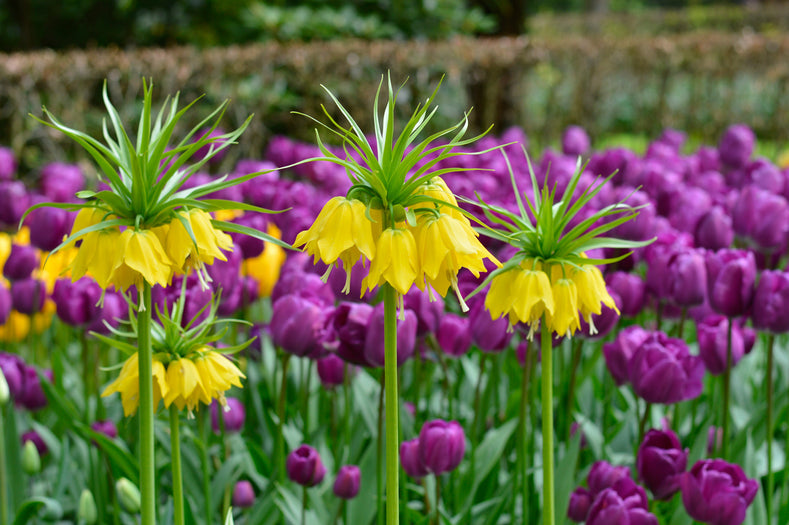Spring: everything comes to life, and the commoner spring flowers are the first that come to mind. Daffodils, crocuses and early tulips are amazing, but what if you’d like something unforgettably different? Most gardeners don’t even think of Fritillarias (also known as Fritillaries) or know what they are, but once you’ve had them in your garden, you won’t be able to imagine spring without them.
A diverse group of plants
Showy Fritillarias range from dwarf plants with blooms 8 to 10 inches tall (Fritillaria meleagris) to long-stemmed showgirls 32 to 36 inches in height (Fritillaria imperialis). Their growing requirements are as different as their looks, with Fritillaria meleagris preferring moist, lightly shaded places to grow, while Fritillaria imperialis in rich gold or hot orange likes full sun and well-drained soils.
Growing Fritillaries in the garden
Fritillaria imperialis (Crown Imperials) have a curious little dimple in the top of the bulb, and the soft, spongy bulbs can rot if they get too much water collecting there. Some gardeners like to plant them in a slightly tilted position to overcome this problem. However, if you have a well-drained soil or a spot such as rockery, this shouldn’t be a problem, since it mimics the natural conditions they like best.
If you’re not sure that your soil is well-drained enough, growing your Crown Imperials in pots will be a safe bet. Choose a tall pot to show off those stunning blooms to the maximum.
Fritillaria Imperialis Rubra Maxima is a gorgeous orange shade whereas Fritillaria Imperialis Lutea Maxima boasts golden yellow blooms.
Fritillaria persica differs from all the other Frittlaries. Imagine a grape Hyacinth that’s tall and super- showy, and you’ll come close to what you can expect from this attractive species. Like the Crown Imperials, Fritillaria Persica likes full sun and well-drained soil and produces tall, purple-black flower spikes that ensure it’s the star of the show.
The smaller Fritillaries are fabulous in mixed meadow plantings or along garden pathways, while the taller ones are a real focal point in any garden. Give them pride of place and plant them in groups for a showy display that will have all your friends and neighbours asking you just what those unusual flowers are.

Fritillarias from DutchGrown
Unlike tulips or narcissi, it’s impossible to produce a generic description that will tell you what to expect. So to make your choices easier, we’ll take a quick tour through the varieties we have on offer:
- Fritillaria imperialis: Yellow ‘Lutea Maxima’ and orange-red “Rubra maxima’. Tall and stately plants for full sun.
- Fritillaria persica: Persica boasts dark purple blooms on tall flower spikes. Full sun
- Fritillaria meleagris: Meleagris grows 8 – 10” tall in a mixture of white, purple red and gorgeously speckled colors. Shade or full sun. Easiest to grow in light shade.
- Fritillaria michailovskyi: Michailovskyi features purple to almost black flowers with yellow accents. Dwarf variety. Shade to full sun.
Just Arrived…
Deserving of a headline all to itself, DutchGrown’s new introduction, Fritillaria Raddeana is a striking, tall, white Fritillary that naturalises well in most areas. We are proud to have this striking new Fritillaria variety in our assortment – be the first to plant it in your garden!


